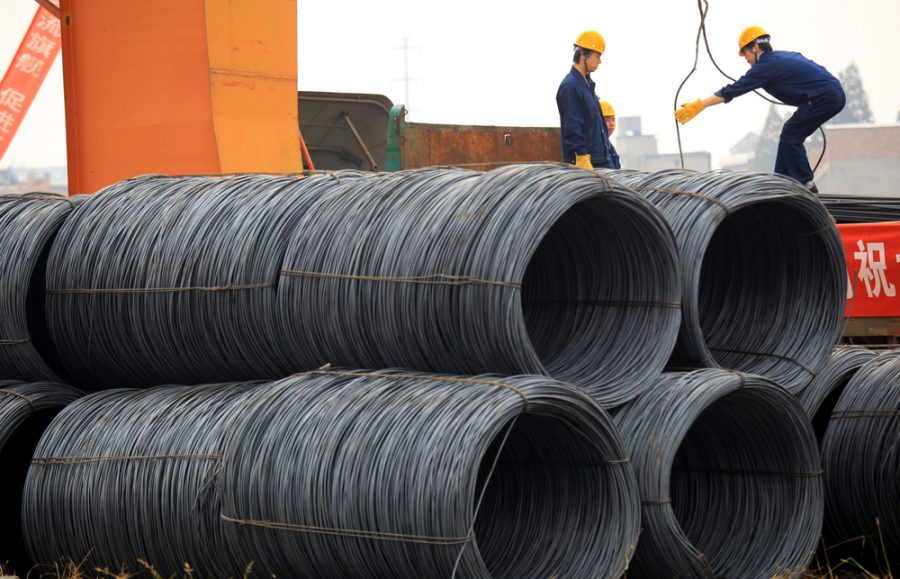
While iron ore has been hammered by the renewed escalation of the U.S.-China trade war, there are also signs the supply crunch that sent prices to a five-year high is easing.
Iron ore futures on the Dalian Commodity Exchange (DCE) fell by the 6% exchange limit during Monday’s trade, after China’s yuan fell to more than seven to the U.S. dollar, its weakest in more than a decade.
The United States responded to the yuan weakening by labelling China a currency manipulator, a move likely to stoke already inflamed trade tensions.
DCE iron ore ended Monday at 709 yuan ($100.71) a tonne, its weakest close in a month, while spot cargoes of benchmark 62% iron ore for delivery to China, as assessed by commodity price reporting agency Argus, finished at $99.80, the softest since June 6.
The spot price is still 32.2% above the level of Jan. 24, the day before a tailings dam collapsed at a mine operated by Brazil’s Vale and left more than 200 dead and dozens still missing.
There are signs that Brazil’s exports are starting to recover, with China, the world’s top buyer, importing the most from the South American nation in July since March
That disaster resulted in the shutdown of several of Vale’s operations for safety checks, cutting shipments from the world’s second-biggest exporter of the steel-making ingredient.
But there are signs that Brazil’s exports are starting to recover, with China, the world’s top buyer, importing the most from the South American nation in July since March.
China imported 17.7 million tonnes from Brazil in July, according to vessel-tracking and port data compiled by Refinitiv, more than double the 7.7 million recorded in June, and almost matching the 18.2 million taken in March.
It’s also likely that China’s imports of Brazilian ore will continue to rise in August, given that Brazil’s July exports rose 16.6% from the previous month to 34.3 million tonnes, according to official data released on Aug. 1.
The improved performance from Brazil comes as Vale was authorised in June to restart operations at its Brucutu mine, which has a capacity of 30 million tonnes a year.
China’s overall imports were also strong in July, coming in at 87.8 million tonnes, up from 76.8 million in June and the strongest month since March.
China’s imports in the April to June period were not only affected by the curtailing of shipments from Brazil, though, as a tropical cyclone in late March idled mines and ports in northwestern Australia, the main producing area in the world’s top exporter.
What the vessel-tracking numbers show is that supply is returning to normal, and therefore the premium prices should start to leave the market.
A further factor worth considering is the level of China’s port inventories, which climbed for a third week in the week to Aug. 2, reaching 121 million tonnes, according to consultancy Steelhome.
While this is still well below the 2019 peak of 148.9 million tonnes, reached in early April, inventories have reversed the downtrend in place for the past three months.
Overall, the iron ore market is experiencing a recovery in supply and inventories, and Chinese demand so far is holding up.
The main risk now is that the trade dispute between the world’s two major economies starts to bite global growth harder, leading to an extended downturn in manufacturing.
While Beijing has a fairly good track record in stimulating its economy out of trouble, there are always questions as to how much more infrastructure and construction can be financed in order to prop up heavy industries such as steel.
It’s worth noting that spot iron ore has dropped by 20.3% from its Aug. 3 peak of $125.20 a tonne, while benchmark Shanghai steel rebar futures have declined by only 8% since their July 1 peak of 4,108 yuan a tonne.
That means Chinese steel mill margins are likely improving, and the depreciation of the yuan isn’t large enough to offset the weaker iron ore price.
This may lend iron ore some support, but probably not enough to prevent prices from slipping back closer to the $75 a tonne seen just before the Vale dam disaster, with the risk of further weakness if the U.S.-China trade war escalates even further.
(By Clyde Russell; Editing by Tom Hogue)
Comments